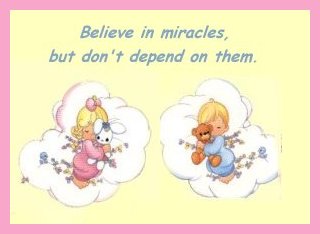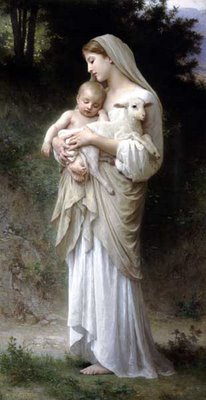Precious Moment Inspiration III
The story of how Precious Moments became porcelain figurines is familiar to many collectors, yet vague on detail and there exists many inaccuracies. What is known to be the status quo story is that Gene Freedman, founding chairman of Enesco, Corp., found Sam Butcher and then convinced Sam to have Yasuhei Fujioka, a Japanese sculptor, bring life to the children as three dimensional figurines.

The beginning
Precious Moments is well known for the porcelain figurines sold by Enesco Corp. since 1977. Sam Butcher originally started scribbling the now famous children with tear-drop shaped eyes on cards and letters to friends and families. In the early days Butcher sold some greeting cards at Christian gift shows and flea markets along with his friend, but sales were meager and localized.
In 1975, Eugene Freedman, who worked for a gift company, befriended Butcher at a show. Freedman liked the characters, but he knew that his company had a late start on the greeting card business, thus needed something else - figurines.
Freedman searched for more than a year looking for a sculptor that could sculpt a figurine that satisfied Butcher's artistic tastes. In 1976, Freedman finally brought the artwork to Nagoya, Japan; where he had previous dealings with the owner and master sculptor, Yasuhei Fujioka.

Enesco
In 1958, Enesco was the import division for the N. Shure Company. When N. Shure was sold to Butler Brothers, the import division was spun-off. Founding President Gene Freedman took the acronym off of the N. Shure cargo, "N S Co" and phonetically named his company "EnEsCo". Thereafter, the company was sold three times, and in 1983 became a part of Stanhome, Inc. After separating from Stanhome in 1998, Stanhome immediately collapsed - leaving Enesco with all of Stanhome's assets.
Sam Butcher originally set up a company under the name of "Jonathan & David" with his friend Bill Biel to sell his artwork and greeting cards. After meeting Freedman, the porcelain figurines were sold under the Jonathan & David distributorship.
But during the mid 1980's (J&D under stamps can be found up until 1986), due to differences in business policies, Biel and Butcher dissolved Jonathan & David. Enesco took over the distributorship world wide from then on. Also around the same time, Butcher set up the "Sam Butcher Foundation" and "Precious Moments, Inc.".
Up until 1997, Enesco's sales for Precious Moments porcelain figurines continued to increase. The collectors' club started from 1980 also saw great increases in membership until then. Enesco was awarded many awards by NALED (National Association of Limited Edition Dealers) during its peak sales years. Freedman and Butcher were also awarded the "Industry Achievement Award" and the "Artist of the Year" respectively numerous times. In its highest sales year, 80% of Enesco's net sales consisted of Precious Moments porcelain figurines.

But by 2004, Enesco, Corp. posted an operating loss of $15.7 million US dollars. The sales of Precious Moments items plunged from a high of $206 million in 1996 to $55.7 million in 2004, a drop of $27.5 million from 2003. (Carthage Press 2005)
"Precious Moments revenues represented 22% of consolidated net revenues in 2004 compared to 33% in 2003," according to Enesco's 2004-2005 annual report.
In 2005 Precious Moments ended its business partnership and license arrangement with Enesco. Precious Moments currently oversees the distribution of its figurines and products, shipping products from its warehouses in Carthage, Mo.
Gene Freedman left Enesco in March of 2005, but has been named "Precious Moments Ambassador" by Precious Moments, Inc. There was an extravagant retirement dinner scheduled for him, but it quickly became an employment celebration after PMI's announcement.
In 2006, only a year after the departure of Precious Moments, Enesco's fourth president, Cynthia Passmore-McLaughlin (formerly of Revlon) resigned. With this, Jim Shore, the second best selling products after Precious Moments, dissolved its crontract with Enesco. Enesco's stocks fell below US $1.00 and was unlisted from the NYSE. After a few weeks of over the counter trading, Enesco withdrew its public offering altogether.

Design originality
Originally, the porcelain figurines were sculpted based on the artwork by Sam Butcher. As seen in the products known as the "Original 21", many of the products were inspired by already existing artwork. Some of the designs, with Middle Eastern garb and sheep, were inspired by traditional Christian artistry from the Middle Ages and the Rennaisance. As is the case with Lladro and Hummel, traditional motifs appear over and over in the product designs.
During the late 70s, other manufacturers were marketing figurines with Victorian design. This was due in part to the Victorian themes being popular amonst Illustrators of the 70s. In the confusion of the new mass market porcelain figurine market, retail stores were lined with similar products from all over the world. In fact, Yasuhei Fujioka's studio desined similar figurines before Freedman brought Precious Moments to him. From early on, the figurine design was more of Fujioka's design than Sam Butcher's.
As figurines sales rose, Sam was forced to create new designs faster. Sam forfeited working on full paintings and started submitting sketches. When figurine sales increased still, Sam began scribbling stick figures on paper napkins. Afterall, he was known for drawing on rocks in the river.
By this time, Shuhei Fujioka had established a company in the USA, that brought the sculpting process closer to Enesco. With the communication time cut in half, Shuhei and his team of sculptors were able to bring a figurine to life from stick figures, slap on Sam's inspirational message, and submit it to Enesco to be marketed as Sam's own design.
When Sam fell ill and could not even scribble any more, PMI brought in ghost writers, rather ghost artists to draw and come up with inspirational titles. At one point, PMI devised a computer montage program that stored "pieces" of drawings like the face, body, arms, and legs, and paste them together to create a new drawing. Most of the times, hedious images of two left handed, twisted body, one eyed children were spat out from the program. Given these "sketches", Shuhei and his team would ignore them and create sculpts to match the inspirational message and fall within Enesco's marketing needs. With sculptors working off of memory, Precious Moments porcelain figurines would inherit more and more aspects of the other products made by Fujioka's company.

The beginning
Precious Moments is well known for the porcelain figurines sold by Enesco Corp. since 1977. Sam Butcher originally started scribbling the now famous children with tear-drop shaped eyes on cards and letters to friends and families. In the early days Butcher sold some greeting cards at Christian gift shows and flea markets along with his friend, but sales were meager and localized.
In 1975, Eugene Freedman, who worked for a gift company, befriended Butcher at a show. Freedman liked the characters, but he knew that his company had a late start on the greeting card business, thus needed something else - figurines.
Freedman searched for more than a year looking for a sculptor that could sculpt a figurine that satisfied Butcher's artistic tastes. In 1976, Freedman finally brought the artwork to Nagoya, Japan; where he had previous dealings with the owner and master sculptor, Yasuhei Fujioka.

Enesco
In 1958, Enesco was the import division for the N. Shure Company. When N. Shure was sold to Butler Brothers, the import division was spun-off. Founding President Gene Freedman took the acronym off of the N. Shure cargo, "N S Co" and phonetically named his company "EnEsCo". Thereafter, the company was sold three times, and in 1983 became a part of Stanhome, Inc. After separating from Stanhome in 1998, Stanhome immediately collapsed - leaving Enesco with all of Stanhome's assets.
Sam Butcher originally set up a company under the name of "Jonathan & David" with his friend Bill Biel to sell his artwork and greeting cards. After meeting Freedman, the porcelain figurines were sold under the Jonathan & David distributorship.
But during the mid 1980's (J&D under stamps can be found up until 1986), due to differences in business policies, Biel and Butcher dissolved Jonathan & David. Enesco took over the distributorship world wide from then on. Also around the same time, Butcher set up the "Sam Butcher Foundation" and "Precious Moments, Inc.".
Up until 1997, Enesco's sales for Precious Moments porcelain figurines continued to increase. The collectors' club started from 1980 also saw great increases in membership until then. Enesco was awarded many awards by NALED (National Association of Limited Edition Dealers) during its peak sales years. Freedman and Butcher were also awarded the "Industry Achievement Award" and the "Artist of the Year" respectively numerous times. In its highest sales year, 80% of Enesco's net sales consisted of Precious Moments porcelain figurines.

But by 2004, Enesco, Corp. posted an operating loss of $15.7 million US dollars. The sales of Precious Moments items plunged from a high of $206 million in 1996 to $55.7 million in 2004, a drop of $27.5 million from 2003. (Carthage Press 2005)
"Precious Moments revenues represented 22% of consolidated net revenues in 2004 compared to 33% in 2003," according to Enesco's 2004-2005 annual report.
In 2005 Precious Moments ended its business partnership and license arrangement with Enesco. Precious Moments currently oversees the distribution of its figurines and products, shipping products from its warehouses in Carthage, Mo.
Gene Freedman left Enesco in March of 2005, but has been named "Precious Moments Ambassador" by Precious Moments, Inc. There was an extravagant retirement dinner scheduled for him, but it quickly became an employment celebration after PMI's announcement.
In 2006, only a year after the departure of Precious Moments, Enesco's fourth president, Cynthia Passmore-McLaughlin (formerly of Revlon) resigned. With this, Jim Shore, the second best selling products after Precious Moments, dissolved its crontract with Enesco. Enesco's stocks fell below US $1.00 and was unlisted from the NYSE. After a few weeks of over the counter trading, Enesco withdrew its public offering altogether.

Design originality
Originally, the porcelain figurines were sculpted based on the artwork by Sam Butcher. As seen in the products known as the "Original 21", many of the products were inspired by already existing artwork. Some of the designs, with Middle Eastern garb and sheep, were inspired by traditional Christian artistry from the Middle Ages and the Rennaisance. As is the case with Lladro and Hummel, traditional motifs appear over and over in the product designs.
During the late 70s, other manufacturers were marketing figurines with Victorian design. This was due in part to the Victorian themes being popular amonst Illustrators of the 70s. In the confusion of the new mass market porcelain figurine market, retail stores were lined with similar products from all over the world. In fact, Yasuhei Fujioka's studio desined similar figurines before Freedman brought Precious Moments to him. From early on, the figurine design was more of Fujioka's design than Sam Butcher's.
As figurines sales rose, Sam was forced to create new designs faster. Sam forfeited working on full paintings and started submitting sketches. When figurine sales increased still, Sam began scribbling stick figures on paper napkins. Afterall, he was known for drawing on rocks in the river.
By this time, Shuhei Fujioka had established a company in the USA, that brought the sculpting process closer to Enesco. With the communication time cut in half, Shuhei and his team of sculptors were able to bring a figurine to life from stick figures, slap on Sam's inspirational message, and submit it to Enesco to be marketed as Sam's own design.
When Sam fell ill and could not even scribble any more, PMI brought in ghost writers, rather ghost artists to draw and come up with inspirational titles. At one point, PMI devised a computer montage program that stored "pieces" of drawings like the face, body, arms, and legs, and paste them together to create a new drawing. Most of the times, hedious images of two left handed, twisted body, one eyed children were spat out from the program. Given these "sketches", Shuhei and his team would ignore them and create sculpts to match the inspirational message and fall within Enesco's marketing needs. With sculptors working off of memory, Precious Moments porcelain figurines would inherit more and more aspects of the other products made by Fujioka's company.













0 Comments:
Post a Comment
<< Home